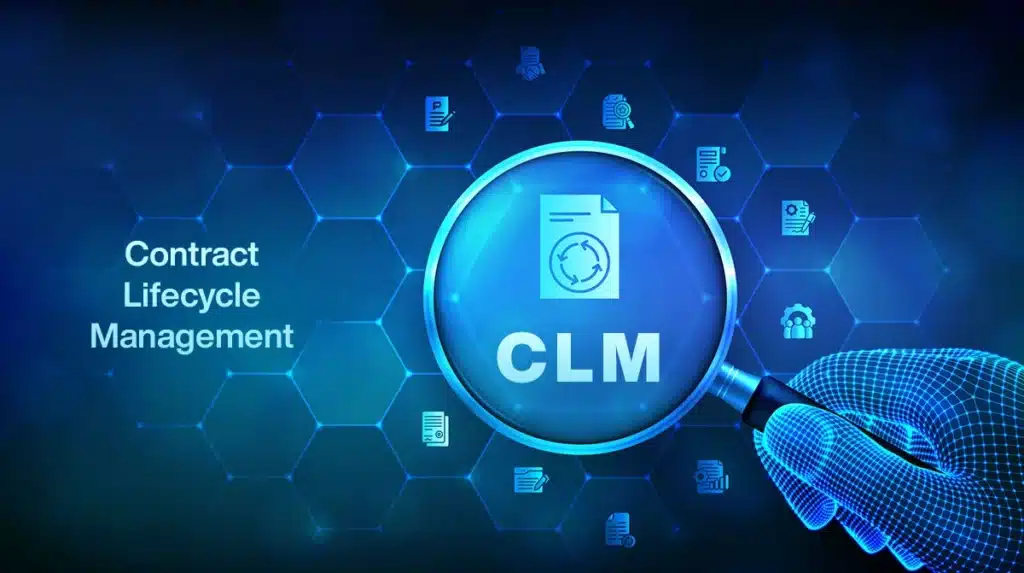Remember the old saying, “An ounce of prevention is worth a pound of cure”? It’s never been truer than in the world of contracts. For too long, businesses have operated in a reactive mode, scrambling to fix problems after they’ve occurred. When a contract dispute arises, a compliance audit uncovers an issue, or a critical deadline gets missed, the team immediately shifts into crisis mode, working together to determine what went wrong.
Managing contracts the traditional way can be risky and inefficient. Missteps can lead to costly penalties, legal issues, and lost opportunities. With the complexity of contracts today, keeping track of everything manually is tough. What if we could prevent problems before they happen? This is becoming possible with AI technology that helps manage compliance and risk throughout the contract process.
Think of AI as your assistant, always monitoring and alerting you to potential issues before they escalate. This proactive approach transforms contract management into a strategic advantage for your business. Let’s explore how this new method is changing the game.
The High Stakes of Contractual Risk and Compliance
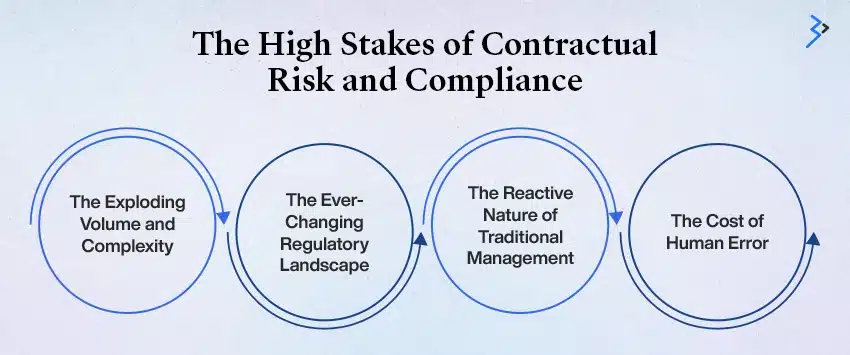
Before we explore the solution, let’s clearly define the problem. The world of contracts is fraught with challenges that traditional methods can’t handle at scale.
Here are some of the major challenges:
1. The Exploding Volume and Complexity: Modern businesses operate globally, forging hundreds, if not thousands, of contracts annually. These aren’t simple agreements either; they often span dozens of pages, containing intricate legal jargon, multiple clauses, and a web of interconnected obligations. Manually tracking every detail, every deadline, and every potential risk across such a massive volume is virtually impossible. The sheer data overload leads to critical information being overlooked.
2. The Ever-Changing Regulatory Landscape: Compliance is a moving target. New regulations emerge, existing laws are updated, and industry-specific rules evolve constantly. Keeping every contract aligned with the latest legal requirements is a monumental task. A single non-compliant clause, unknowingly overlooked, can expose an organization to severe penalties, fines, and legal action. The legal and financial implications of non-compliance can be catastrophic.

3. The Reactive Nature of Traditional Management: Most companies only engage with contracts when a problem arises. They wait for a missed payment, a breach of terms, or a dispute before they dive deep into the contractual text. This reactive stance means they are always playing catch-up, spending valuable time and resources on remediation rather than prevention. This approach not only costs money but also damages trust and relationships.
4. The Cost of Human Error: Even the most meticulous legal professionals can make mistakes when reviewing thousands of pages of dense legal text. Fatigue, distraction, or overwhelming volume can lead to missed details – a forgotten auto-renewal date, a vague indemnification clause, or an inconsistent term across related agreements.
These errors are not just minor oversights but potential liabilities waiting to explode. A study by ContractPodAi found that up to 70% of legal team time is spent on manual, repetitive tasks, significantly increasing the risk of human error in high-volume contract review.
These challenges paint a clear picture~ the traditional contract compliance and risk management approach is no longer sustainable. It’s time for a more innovative, more proactive solution.
Generative AI: The Shift from Reactive to Proactive
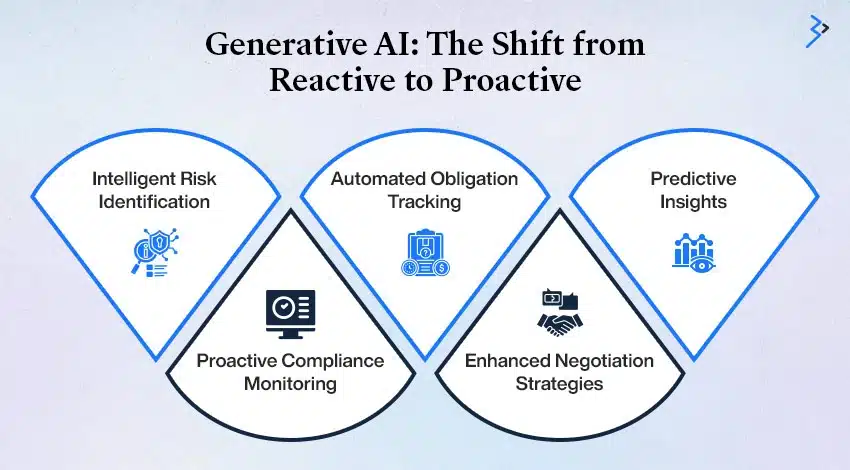
Enter Generative AI. Unlike traditional automation, which is good at following strict rules, Generative AI understands context, meaning, and intent. It can analyze vast amounts of textual data, identify patterns, and generate new content, making it uniquely powerful for contract management. Companies are increasingly looking for Generative AI Development Services to leverage these capabilities in their legal and compliance workflows.
Here’s how Generative AI transforms the game:
- Intelligent Risk Identification: Generative AI doesn’t just look for keywords; it understands the implications of specific clauses. It can read an entire contract and pinpoint ambiguous language, identify potential liabilities, or flag terms that deviate from your company’s standard playbooks.
- Proactive Compliance Monitoring: AI can continuously scan your contract portfolio against the latest regulatory updates instead of waiting for an audit. It can identify contracts needing revision due to new laws, ensuring you stay compliant before issues arise.
- Automated Obligation Tracking: Contracts are full of obligations and deadlines. Generative AI can extract these commitments, create computerized alerts, and track their fulfillment, ensuring nothing falls through the cracks.
- Enhanced Negotiation Strategies: During negotiations, AI can quickly analyze proposed changes, identify their impact on risk and compliance, and suggest alternative language that aligns with your company’s risk appetite.
- Predictive Insights: By analyzing historical contract data, AI can even predict potential disputes or areas of high risk, allowing you to take preventative measures.
The result is a shift from a reactive, crisis-driven approach to a proactive, strategically managed contract lifecycle. Research by Deloitte suggests that organizations adopting AI for legal tasks can expect reductions in legal spend by 10-20% through improved efficiency and risk mitigation.
Read More – Generative AI: Redefining the Boundaries of Traditional Machine Learning
Generative AI in Action: Real-World Transformations
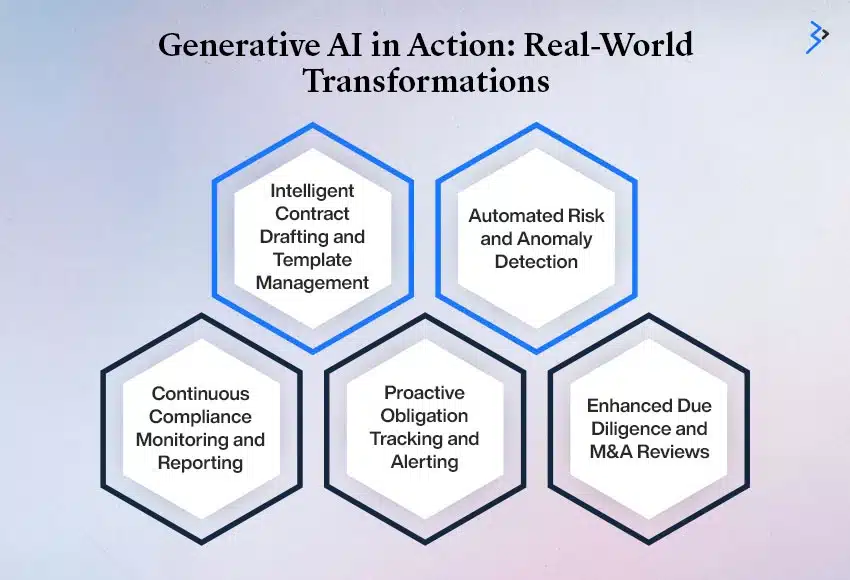
Let’s look at how Generative AI powers this proactive shift across key areas of contract management:
1. Intelligent Contract Drafting and Template Management: No more starting from scratch. Generative AI can draft initial contract templates based on your company’s historical agreements, standard clauses, and legal playbooks. Need a specific clause for a unique situation? AI can generate relevant, legally sound options.
It ensures consistency across all contracts and significantly speeds up the initial creation phase. Automatically updating templates to reflect changes in compliance standards ensures that every new contract remains compliant from day one.
2. Automated Risk and Anomaly Detection: This is where AI truly shines in preventing issues. Generative AI can scan a contract for deviations from standard terms, highlight clauses that expose your company to undue risk (e.g., unbalanced indemnification, unfavorable termination clauses), and even detect subtle inconsistencies across related documents.
It’s like having an army of legal experts reviewing every word, every minute, for potential pitfalls. AI actively identifies issues before the exchange of signatures, eliminating the need for manual review.
3. Continuous Compliance Monitoring and Reporting: The regulatory landscape doesn’t sleep, and neither does AI. Generative AI tools can continuously monitor your contract portfolio against the latest legal and regulatory requirements. When a new data privacy law, such as an update to GDPR, is introduced, the AI identifies all affected contracts and flags them for review or amendment.
It generates real-time compliance reports, giving you an immediate overview of your contractual health and identifying areas that need attention, significantly lowering the chances of incurring penalties for non-compliance.
4. Proactive Obligation Tracking and Alerting: Contracts include various obligations, such as delivery dates, payment schedules, reporting requirements, and renewal options. Manually tracking these across hundreds or thousands of contracts is a nightmare. Generative AI extracts these obligations, sets up automated alerts for approaching deadlines, and monitors for triggers that might initiate a specific action (e.g., a performance metric being met).
We can prevent oversights and strengthen our business relationships by actively tracking essential commitments. Contract Management: An Overlooked Driver of Business Agility and Financial Performance shows businesses lose almost 9% of value annually due to poor contract management.
5. Enhanced Due Diligence and M&A Reviews: During mergers and acquisitions, the volume of contracts requiring review is staggering, and time is of the essence. Generative AI can swiftly analyze thousands of contracts, extracting key provisions, identifying change-of-control clauses, and flagging potential liabilities in a fraction of the time it would take human teams.
The process speeds up due diligence, lowers costs, and provides decision-makers with a complete and precise risk profile, facilitating quicker and more informed deal-making.
Read More – How to Use Generative AI to Its Full Potential in Your Adobe Commerce Store
Overcoming the Challenges of Adoption
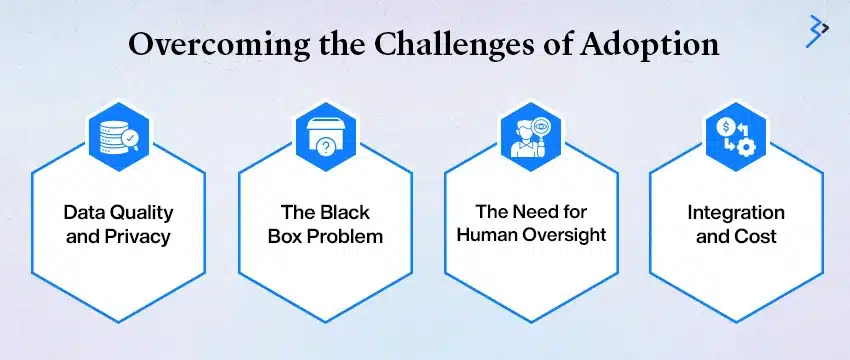
While the promise of AI-driven contract management is clear, adopting this technology isn’t without its challenges. Organizations must prepare to address these to ensure a smooth and successful transition.
- Data Quality and Privacy: The data quality used to train AI models determines their effectiveness. Ensuring a secure, private, and high-quality dataset of your contracts is paramount. Companies often prefer to train AI models on their internal contract repositories rather than relying on generic public data to maintain confidentiality and accuracy.
- The “Black Box” Problem: Some AI models operate as “black boxes,” providing answers without explaining their reasoning. This is a significant issue in legal work where accountability and justification are crucial. Organizations should actively seek custom AI solutions that include Explainable AI (XAI) features, allowing legal professionals to understand the reasons behind flagged clauses or suggestions.
- The Need for Human Oversight: Generative AI is a powerful assistant, not a replacement. Human oversight remains absolutely crucial. Lawyers shift from manual, repetitive tasks to focusing on strategic analysis, creative problem-solving, and the final expert review of AI-generated outputs to ensure legal soundness and contextual accuracy—AI augments, it doesn’t automate away, the legal professional.
- Integration and Cost: Implementing new AI systems can be complex and requires investment. It’s vital to have a clear strategy for integrating AI with your existing CRM through CRM development services to maximize efficiency and streamline operations. ERP, and legal tech stack. Organizations should actively invest in both technology and the upskilling of their teams. Over half of organizations already see return-on-investment (ROI) directly or indirectly from their AI adoption. Tech.co summarizing Thomson Reuters’ Future of Professionals Report 2025 findings validates this.
Conclusion: Partnering for Proactive Protection
The era of reactive contract management is rapidly coming to an end. AI-driven compliance and risk management in the contract lifecycle transforms how businesses operate, from simply responding to issues to proactively preventing them. This shift accelerates approvals, lowers risk, and frees legal and business professionals to focus on strategic, high-value work that drives growth.
At Brainvire, we know that each organization has different needs and a unique risk appetite. We help you create a roadmap for adopting AI, secure your data, and customize our solutions to fit your specific workflows and compliance needs.
With our expertise, your business can confidently embrace this change, turning an often slow and difficult process into a powerful source of competitive advantage and proactive protection. The future of contract management is not just about automation; it’s about intelligent, strategic foresight.
FAQs:-
Traditional tools mostly automate repetitive tasks like storing documents or setting reminders. AI, on the other hand, actually understands contract language, detects risks, ensures compliance with evolving regulations, and even predicts potential disputes before they occur—making it proactive instead of reactive.
Yes—Generative AI is trained on massive datasets of contracts and legal texts, allowing it to recognize context, intent, and risk beyond simple keyword detection. While it won’t replace human judgment, it acts as a powerful assistant that flags issues, suggests alternatives, and reduces the chance of human oversight.
AI continuously scans existing contracts against the latest regulatory updates. For example, if a new privacy law emerges, AI can immediately flag all contracts containing outdated clauses, helping businesses stay compliant without waiting for costly audits.
Related Articles
-
AI-Driven Personalized Product Recommendation: Use Cases and Benefits
A 21st-century customer craves a personalized shopping experience that makes them feel included and validates their preferences. Meeting consumer expectations for any e-commerce brand takes work, especially in a fast-paced
-
Maximizing Employee Engagement with AI-Driven HR Strategies
Did you know the average time to fill a role is 36 days? Among the numerous HR activities, the recruitment process involves multiple layers and is time-consuming. Incorporating AI in employee
-
Digital Product Engineering: Transforming Ideas into Market-Ready Solutions
As an entrepreneur, you will always seek strategies and solutions to take your business to the next paradigm. Doing that is not easy, as identifying tools and methods to multiply

